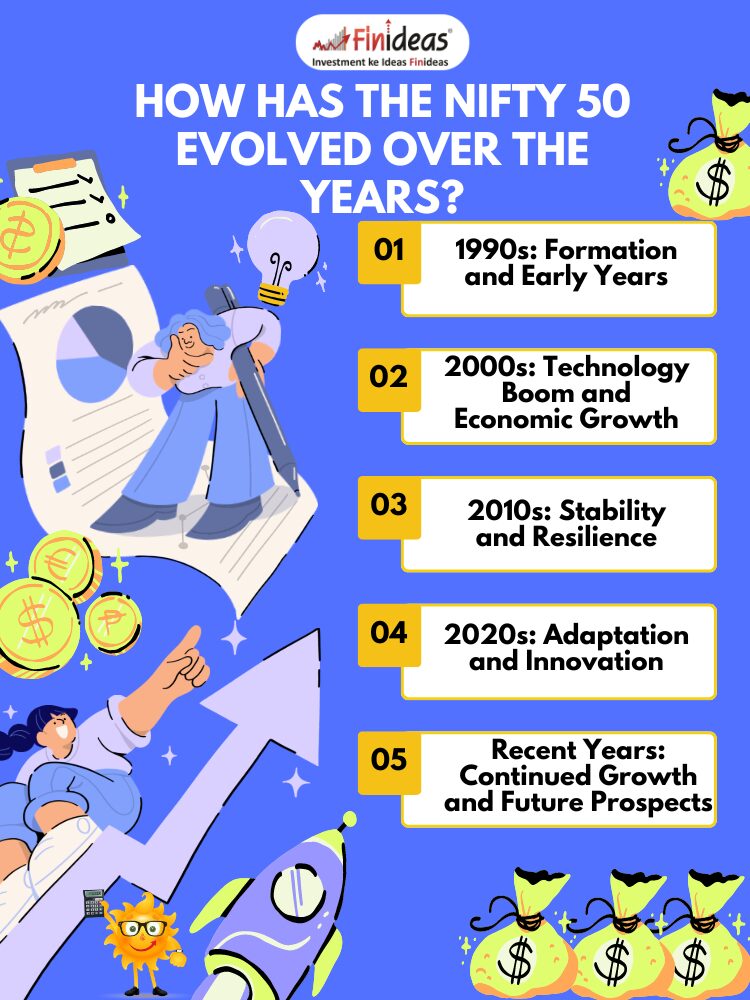The Evolution of NIFTY 50 History and Performance Analysis
The NIFTY 50 is a benchmark Indian stock market index representing the weighted average of 50 of the largest Indian companies listed on the National Stock Exchange (NSE). It covers various sectors of the economy, providing a snapshot of the market’s performance.
How Did the NIFTY 50 Begin?
The NIFTY 50 was launched on April 22, 1996, by the NSE. Initially, it included 50 diversified companies, selected based on their market capitalization and liquidity. The index aimed to provide a reliable indicator of the Indian stock market’s health.
How Has the NIFTY 50 Evolved Over the Years?
- 1990s: Formation and Early Years: In its early years, the NIFTY 50 focused on establishing itself as a credible benchmark. The initial phase saw significant growth, with many companies gaining prominence in the market.
- 2000s: Technology Boom and Economic Growth: The early 2000s witnessed a technology boom, with IT companies like Infosys and TCS contributing significantly to the index’s growth. The Indian economy’s expansion during this period also positively impacted the NIFTY 50.
- 2010s: Stability and Resilience: The last decade has been marked by stability and resilience. Despite global financial crises, the NIFTY 50 has shown consistent performance, reflecting the underlying strength of the Indian economy.
- 2020s: Adaptation and Innovation: The 2020s have brought new challenges and opportunities for the NIFTY 50. The COVID-19 pandemic initially caused significant volatility, but the index demonstrated remarkable recovery and resilience. The period also saw increased emphasis on digital transformation and innovation, with sectors like e-commerce, pharmaceuticals, and renewable energy gaining traction.
- Recent Years: Continued Growth and Future Prospects: In recent years, the NIFTY 50 has continued its growth trajectory, driven by robust corporate earnings, economic reforms, and increased foreign investments. As of 2024, the index has reached new heights, reflecting the dynamic and evolving nature of the Indian economy. The future looks promising, with potential growth in sectors like technology, healthcare, and green energy expected to further bolster the index.
What is the Current Composition of the NIFTY 50?
As of now, the NIFTY 50 includes companies from various sectors such as IT, finance, consumer goods, pharmaceuticals, and energy. This diversification helps mitigate sector-specific risks and provides a balanced view of the market. So if you are someone who is interested to Invest in Index fund nifty 50 then you must know about Index Long Term Strategy.
How Has the NIFTY 50 Performed Historically?
- Initial Growth In its initial years, the NIFTY 50 saw substantial growth. For example, the index value increased from around 1,000 points in 1996 to over 6,000 points by the end of 2006, reflecting a compound annual growth rate (CAGR) of approximately 19%.
- Recent Performance In the past decade, the NIFTY 50 has continued to perform well. As of 2023, the index is hovering around 18,000 points. This growth is driven by various factors, including economic reforms, foreign investments, and corporate earnings growth.
- Long-Term Perspective Over a 25-year period, the NIFTY 50 has delivered an average annual return of about 12%, making it a lucrative option for long-term investors. Investing in the NIFTY 50 through index funds has become a popular strategy due to its diversification and stable returns.
Why Should You Consider Investing in the NIFTY 50?
- Diversification: Investing in the NIFTY 50 index fund provides exposure to 50 large-cap companies across various sectors, reducing the risk associated with investing in a single company or sector.
- Long-Term Growth: Historical data shows that the NIFTY 50 has consistently delivered strong returns over the long term, making it an attractive option for investors looking for steady growth.
- Ease of Investment: Index funds that track the NIFTY 50 are easily accessible and require minimal active management, making them suitable for both novice and experienced investors.
How Can You Invest in the NIFTY 50?
- Direct Investment: You can directly invest in the NIFTY 50 through stocks of the companies listed in the index.
- Index Funds: Another popular way is to invest in NIFTY 50 index funds or exchange-traded funds (ETFs). These funds replicate the performance of the NIFTY 50 and are a cost-effective way to gain exposure to the index.
What Are the Benefits of Investing in NIFTY 50 Index Funds?
- Low Cost: Index funds typically have lower expense ratios compared to actively managed funds, making them a cost-effective investment option.
- Reduced Risk: By investing in a diversified set of 50 companies, you reduce the risk associated with individual stock investments.
- Transparency: The composition and performance of the NIFTY 50 are publicly available, providing transparency to investors.
What Do You Think About Investing in the NIFTY 50?
Considering its historical performance and the benefits of diversification, investing in the NIFTY 50 can be a smart choice for long-term investors. What factors do you consider most important when deciding to invest in an index fund like the NIFTY 50? Let us know in the comments below!
Happy Investing!
This article is for education purpose only. Kindly consult with your financial advisor before doing any kind of investment..


